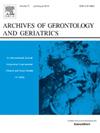AGING AND VESTIBULAR SYSTEM: SPECIFIC TESTS AND ROLE OF MELATONIN IN COGNITIVE INVOLVEMENT
IF 3.5
3区 医学
Q2 GERIATRICS & GERONTOLOGY
引用次数: 0
衰老与前庭系统:褪黑素在认知参与中的特定测试和作用
随着年龄的增长,平衡失调很常见。它们尤其重要,因为它们降低了老年人的社会自主权,而且经常引起跌倒。原因总是多因素的。有证据表明,衰老会影响多种感觉输入,以及肌肉骨骼系统和中枢神经系统进行感觉运动整合的能力。为了评估老年人平衡能力下降,编制了一份专门的调查问卷,以识别跌倒的高风险,称为跌倒风险量表(FRI),并研究了一项复杂的心理-感觉-运动测试,以检测特异性前庭功能障碍。关于老年受试者平衡障碍的埃塞俄比亚发病机制,由于行为和认知表现的下降也是由于生物节律控制的下降,褪黑激素(调节昼夜节律的激素)的作用与小脑功能密切相关,众所周知,老年人小脑在运动和认知方面都有调节作用。本文的目标是:(i)提出一份自我管理的FRI问卷,旨在确定老年人跌倒的可能原因并量化跌倒风险。(ii)验证体位摄影作为研究老年人前庭受累与FRI相关的特殊测试的有效性。(iii)提出一种复杂行为测试(NT),旨在评估老年人的空间定向和空间记忆,以及导致复杂头晕和不稳定的因素。(iv)通过昼夜节律、小脑平衡紊乱和认知障碍之间的功能相关性,评估褪黑素在眩晕、老年受试者认知参与中的作用。总的结论是:FRI与风险下降相关。姿势照相识别与平衡障碍和老年人跌倒相关的特定前庭损伤。大约40%的眩晕患者的空间定向发生改变,但褪黑素节律没有明显差异。空间记忆只有在褪黑素昼夜节律反转的受试者中才会发生高度改变,因此可以假设正常褪黑素昼夜节律的改变在某些亚群患者的头晕发生中起一定作用。
本文章由计算机程序翻译,如有差异,请以英文原文为准。
求助全文
约1分钟内获得全文
求助全文
来源期刊
CiteScore
7.30
自引率
5.00%
发文量
198
审稿时长
16 days
期刊介绍:
Archives of Gerontology and Geriatrics provides a medium for the publication of papers from the fields of experimental gerontology and clinical and social geriatrics. The principal aim of the journal is to facilitate the exchange of information between specialists in these three fields of gerontological research. Experimental papers dealing with the basic mechanisms of aging at molecular, cellular, tissue or organ levels will be published.
Clinical papers will be accepted if they provide sufficiently new information or are of fundamental importance for the knowledge of human aging. Purely descriptive clinical papers will be accepted only if the results permit further interpretation. Papers dealing with anti-aging pharmacological preparations in humans are welcome. Papers on the social aspects of geriatrics will be accepted if they are of general interest regarding the epidemiology of aging and the efficiency and working methods of the social organizations for the health care of the elderly.

 求助内容:
求助内容: 应助结果提醒方式:
应助结果提醒方式:


